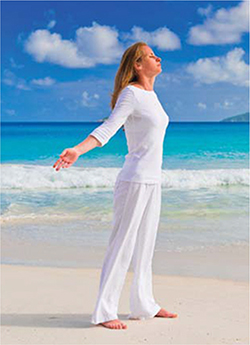
Meditation is discussed throughout this book as a spiritual practice that involves sitting or standing quietly and focusing your attention inward to achieve a state of calm or to perform deep personal exploration. However, that’s not the only form meditation can take. Active meditation is a style of meditation that includes physical movements, such as jumping or dancing, followed by silence. The movements allow for both physical and emotional release, while giving the mind a break from thought and worry.
The Indian mystic, guru, and spiritual teacher Osho (1931–1990) created a number of active meditation techniques, which he believed were more applicable to modern life than traditional meditation practices. One such technique is called “dynamic meditation,” which involves four stages of movement with music and one stage of silent reflection. Osho’s other active meditation methods include kundalini “shaking” meditation, which involves shaking the body and dancing, and nadabrahma “humming” meditation, which involves humming and hand movements. Osho also believed these active meditation techniques served as helpful preparation for more traditional meditation.

Active meditation has many of the same benefits as standard meditation, plus a few bonus perks. In addition to calming the mind, you also get to invigorate the body by using your muscles, getting your heart rate up, and boosting blood circulation. You can practice active meditation alone or in a group setting. There are many online tutorials and videos that can help you practice at home, or you can attend a class, workshop, or retreat in your area. There is also a wide variety of active meditation music available for download or streaming online. As with any type of meditation, it’s helpful to set an intention for your session before you begin. You can focus on this intention mentally or announce it out loud as a chant or a mantra (see entries in Chapter 6).